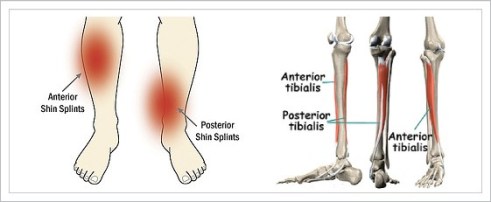High-impact exercises, new workout routines, and overuse of muscles connected to the shinbone (tibia) cause shin splints. The recurring leg pain can make movements such as running, jumping, and sprinting difficult and restrictive. With proper physical therapy for shin splints, you can prevent this from possibly turning into a stress fracture or something even worse.
Overview
The shinbone (or tibia) is the largest bone in the lower leg. It’s present at the outer end of your leg. Shin splints occur primarily when the anterior tibialis, a muscle on the outside half of the lower leg, is overworked, repeatedly stressed, and suffers undue pressure and strain.

The leg pain arises after muscles surrounding the shinbone become inflamed due to overuse. It tends to happen after repetitive movements, intense workouts, and a sudden increase in physical activities. Starting to train for a marathon too quickly, sports that require significant amounts of jumping, and increasing your Crossfit routine can contribute to shin splints.
Medically, the condition is labeled as medial tibial stress syndrome (MTSS) or anterior tibialis tendonitis. If left untreated, it can develop into a stress fracture, increasing the risk of mobility issues. That is why you must receive sufficient rest and proper guidance on performing high-impact and intense activities without any harm.
Symptoms of Shin Splints
Common symptoms of shin splints include:
- A dull throbbing or sharp leg pain in your lower limb
- Soreness or tenderness along your shinbone
- Continuous leg pain
- Mild swelling and inflammation in the affected area
- Discomfort during the start/end of workout sessions
- Pain which occurs when you are jumping or running downhill
In severe cases, shin splints can develop into stress fractures of the tibia. Early shin splints treatment and targeted treatment can prevent this from happening.
Causes of Shin Splints
Athletes (mostly runners), dancers, people with osteoporosis, and those with military training often deal with shin splints.
The main causes include:
- Excessive wear and tear of the shinbone and connective muscles due to repetitive activity
- A sudden change in the intensity, frequency, or length of your workout session
- Wearing improper (or worn out) footwear during exercise or daily training
- A genetic defect like flat feet or high arches
- Vitamin D deficiency
- Overweight
Diagnosis
Our physical therapists perform a full physical examination before we treat shin splints. The assessment includes a comparative study of medical history, current symptoms, and what everyday activities are inhibited. We may ask you to walk or climb the stairs to observe the debilitative impact of your condition. Jumping in place or performing eccentric squats can also help to identify the true source of pain.
After identifying the pain pattern and intensity, we provide personalized shin splints treatment.
Treatment: Physical Therapy Protocol for Shin Splints
Every patient presents with similar symptoms, but how to deal with shin splints can vary significantly. It all depends on your goals and current limitations. We treat shin splints by instructing and demonstrating the best stretches for shin splints to perform at home.
In the clinic, focus on manual therapy, massage, leg mobility, and exercises for overall lower extremity strength. This dual approach helps reduce symptoms and regain movement in the affected area.
We recommend and teach muscle strengthening and physical therapy exercises for shin splints to optimize functionality levels and flexibility. These low-impact workouts support movement and build stamina as you return to everyday activities.
With time, the leg pain and associated inflammation can usually subside. We also create customized rehabilitation programs for athletes if required and provide the best stretches for shin splints specifically geared to help their recovery. These may help individuals to recover from sports injuries and prevent long-term issues.
Apart from this, we suggest adequate footwear or orthotics dependent upon your foot type and what sport/recreational activity you are returning to after recovering from shin splints. With these footwear changes, you will have an easier time walking, running, jumping and will receive the proper support during athletic activities.
Overall, shin splints are a relatively common overuse injury with multiple treatment options. We decide the best route based on individual symptoms and continuously encourage your shin splints recovery.
Call us @ 201-773-8851 or contact us to schedule an initial evaluation for physical therapy for shin splints.

